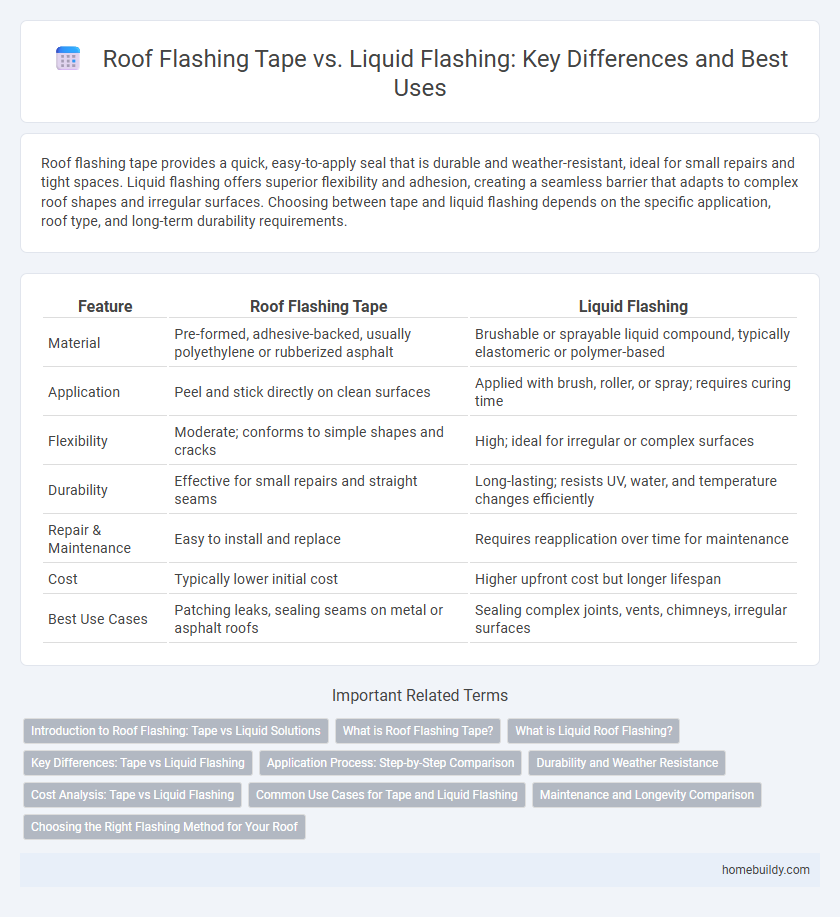Roof flashing tape provides a quick, easy-to-apply seal that is durable and weather-resistant, ideal for small repairs and tight spaces. Liquid flashing offers superior flexibility and adhesion, creating a seamless barrier that adapts to complex roof shapes and irregular surfaces. Choosing between tape and liquid flashing depends on the specific application, roof type, and long-term durability requirements.
Table of Comparison
| Feature | Roof Flashing Tape | Liquid Flashing |
|---|---|---|
| Material | Pre-formed, adhesive-backed, usually polyethylene or rubberized asphalt | Brushable or sprayable liquid compound, typically elastomeric or polymer-based |
| Application | Peel and stick directly on clean surfaces | Applied with brush, roller, or spray; requires curing time |
| Flexibility | Moderate; conforms to simple shapes and cracks | High; ideal for irregular or complex surfaces |
| Durability | Effective for small repairs and straight seams | Long-lasting; resists UV, water, and temperature changes efficiently |
| Repair & Maintenance | Easy to install and replace | Requires reapplication over time for maintenance |
| Cost | Typically lower initial cost | Higher upfront cost but longer lifespan |
| Best Use Cases | Patching leaks, sealing seams on metal or asphalt roofs | Sealing complex joints, vents, chimneys, irregular surfaces |
Introduction to Roof Flashing: Tape vs Liquid Solutions
Roof flashing tape provides a durable, flexible barrier that seals joints and prevents water infiltration with easy application and strong adhesion, ideal for quick repairs and tight spaces. Liquid flashing offers a seamless, customizable coating that conforms to irregular surfaces, creating a watertight membrane that enhances long-term protection against leaks. Choosing between tape and liquid flashing depends on the project's complexity, surface texture, and the desired level of moisture resistance.
What is Roof Flashing Tape?
Roof flashing tape is a self-adhesive material designed to seal joints and prevent water infiltration around roof penetrations such as chimneys, vents, and skylights. Made from durable, waterproof materials like butyl or rubberized asphalt, it provides a flexible and long-lasting barrier against moisture. This tape is valued for its ease of application and strong adhesion to various roofing surfaces.
What is Liquid Roof Flashing?
Liquid roof flashing is a flexible, waterproof coating applied as a liquid to seal joints, seams, and cracks on roofs, providing superior adhesion and durability compared to traditional tapes. It conforms to irregular surfaces, creating a seamless barrier that prevents water infiltration and resists UV damage and temperature fluctuations. Commonly made from elastomeric polymers, liquid flashing is ideal for complex roof details and repairs where durable, watertight seals are critical.
Key Differences: Tape vs Liquid Flashing
Roof flashing tape offers a quick, easy-to-apply solution with strong adhesion and waterproof properties, ideal for sealing small gaps and joints on roofing surfaces. Liquid flashing provides greater flexibility and durability by creating a seamless, continuous barrier that conforms to complex shapes and irregular surfaces, making it suitable for long-lasting protection against water infiltration. The choice between tape and liquid flashing depends on the specific application, surface type, and desired durability, with tape excelling in convenience and liquid flashing in comprehensive coverage.
Application Process: Step-by-Step Comparison
Roof flashing tape offers a straightforward application process, requiring a clean, dry surface before peeling and pressing the adhesive tape firmly over seams or joints, ensuring immediate waterproofing. Liquid flashing involves a more detailed procedure, including surface preparation, priming if necessary, and careful brushing or spraying of multiple liquid layers to create a seamless, flexible membrane. Both methods demand careful surface preparation, but flashing tape provides quicker application while liquid flashing offers enhanced adaptability on irregular surfaces.
Durability and Weather Resistance
Roof flashing tape offers excellent durability with strong adhesive properties that resist peeling and cracking under extreme weather conditions, making it highly effective for sealing joints and preventing water infiltration. Liquid flashing provides superior weather resistance by creating a seamless, flexible barrier that conforms to irregular surfaces and withstands UV exposure, temperature fluctuations, and moisture over time. Both materials enhance roof protection, but liquid flashing generally outperforms tape in long-term weatherproofing due to its continuous, monolithic coating.
Cost Analysis: Tape vs Liquid Flashing
Roof flashing tape generally costs less per linear foot compared to liquid flashing, making it a budget-friendly option for small repairs and straightforward applications. Liquid flashing requires more material and labor time, which increases the overall expense but provides superior flexibility for complex roof penetrations and irregular surfaces. Choosing between tape and liquid flashing depends on balancing initial material costs against long-term durability and application complexity.
Common Use Cases for Tape and Liquid Flashing
Roof flashing tape is commonly used for quick repairs, sealing small gaps, and reinforcing seams around vents, skylights, and chimneys due to its easy application and adhesive properties. Liquid flashing, applied with a brush or trowel, is ideal for complex roof details, irregular surfaces, and creating a seamless waterproof barrier around roof penetrations and joints. Tape is favored for its speed and clean installation, while liquid flashing excels in areas requiring flexible, durable, and airtight protection.
Maintenance and Longevity Comparison
Roof flashing tape offers a durable, weather-resistant seal that requires minimal maintenance, making it ideal for quick repairs and long-term durability. Liquid flashing, while providing seamless coverage that conforms to complex shapes, may necessitate periodic inspections and touch-ups to maintain its protective barrier against moisture. Both options extend roof lifespan effectively, but tape typically offers greater longevity with less frequent upkeep in standard applications.
Choosing the Right Flashing Method for Your Roof
Roof flashing tape offers quick, easy application with strong adhesion ideal for small repairs and tight corners, enhancing waterproofing on roof seams and joints. Liquid flashing provides superior flexibility and seamless coverage, making it suitable for complex roof shapes and long-term durability against weather exposure. Selecting the right flashing method depends on roof material, damage type, and project scope to ensure optimal protection and lifespan.
Roof flashing tape vs liquid flashing Infographic

 homebuildy.com
homebuildy.com